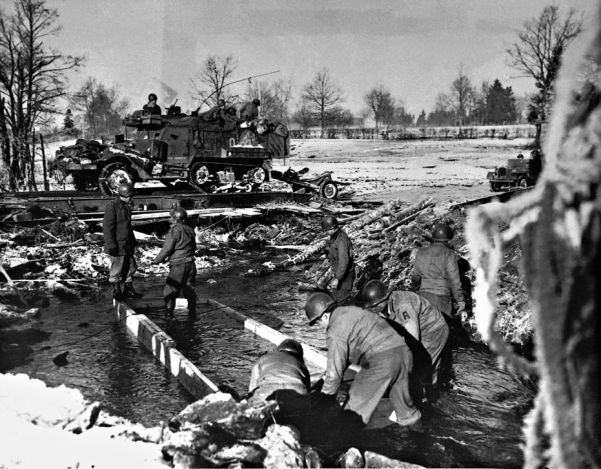1 March
Eastern Front, Germany
Marshal Georgi Zhukov’s 1st Belorussian Front begins an offensive to destroy the German Third Panzer Army - which has 203,000 men, 700 tanks, 2500 guns, and 100 coastal artillery and fixed anti-aircraft guns - as part of the Red Army’s effort to secure its flanks prior to the assault on Berlin itself.
3 March
Western Front, France

In snow and freezing rain, General George Patton unleashes his US Third Army over the Kyll River toward the Rhine. The attack is spearheaded by the VIII and XII Corps, which make good progress.
Eastern Front, Germany
In an effort to try to recapture the lost defenses on the Oder River, the German Fourth Panzer Army counterattacks from the Lauban area toward Glogau. However, strong Soviet entrenched positions stop the attack in its tracks.
Far East, Burma
General David Cowan’s 17th Indian Division and 255th Indian Tank Brigade take the communications center of Meiktila after heavy fighting.
4 March
Pacific, Iwo Jima
The first US B-29 Superfortress bomber lands on the island.
6 March
Eastern Front, Hungary
The Germans launch Operation Spring Awakening, designed to secure the Nagykanizsa oil fields, retake Budapest, and win a prestigious victory on the Eastern Front. The Sixth SS Panzer and Second Panzer Armies make good initial progress despite very poor weather conditions.
7 March
Politics, Yugoslavia
Marshal Tito forms a provisional government in which he accepts representatives of the former royalist government-in-exile. This is a temporary measure, as he intends to retain full control of the government for the Communist Party, which he believes the population will accept without question as a result of partisan successes during the war.
Western Front, Germany

Units of the US First Army capture the Ludendorff bridge over the Rhine River at Remagen. The bridge, having withstood bombs, demolition, heavy usage, and artillery shells, collapses into the river 10 days later.
10 March
Western Front, Germany
Field Marshal Bernard Montgomery’s 21st Army Group completes the conquest of the area west of the Rhine River. The group has lost 22,934 casualties, although the Germans have suffered casualties totaling 90,000 men defending the area immediately west of the Ruhr.
Air War, Japan
The first American fire raid on Japan, against Tokyo, burns out over 16 square miles (25.6 sq km) of the city and kills 100,000 people.
14 March
Western Front, Germany
General George Patton’s US Third Army crosses the lower Moselle River to cut behind the German Siegfried Line defensive system.
16 March
Eastern Front, Hungary
Marshal Fedor Tolbukhin’s 3rd Ukrainian Front commences the Red Army’s counterattack against Operation Spring Awakening on the Front between Lake Velencei and Bicske. The German IV SS Panzer Corps holds in the face of overwhelming superiority in tanks and men, but the Hungarian Third Army on the left collapses.
Pacific, Iwo Jima
The island of Iwo Jima is declared secure by the Americans following 26 days of combat. They have lost 6821 soldiers and sailors dead, while of the 21,000 Japanese garrison, only 1083 are taken prisoner. The rest have been killed or have committed suicide.
17-19 March
Far East, Burma
The battle for Mandalay begins. The main Japanese garrison is situated in Fort Dufferin, which is pounded incessantly by British artillery. Following an intensive aerial bombardment, the Japanese evacuate the fort on the 19th - Mandalay is in British hands.
18 March
Pacific, Philippines
In the island-hopping campaign in the theater, the US 40th Division lands on Panay, secures it, and then moves on to clear nearby Guimaras Island.
20 March
Eastern Front, Germany
Units of the 1st Belorussian Front storm Altdamm. There are now no German positions on the east bank of the northern Oder River.
22-31 March
Western Front, Germany

The Allied crossings of the Rhine River begin. The 5th Division of the US Third Army crosses the Rhine near Nierstein and Oppenheim and establishes bridgeheads on the east bank. By the end of the 23rd, the whole of the division is over the river. German resistance is negligible. Field Marshal Bernard Montgomery’s 21st Army Group (1.25 million men) begins crossing the river on the 23rd, when the British 51st (Highland) Division and the Canadian 3rd Division cross near Rees and Emmerich. On the 24th, the US 87th Division crosses at Boppard and the 89th at St. Goer, while farther north the British 6th and the US 17th Airborne Divisions land east of the Rhine and link up with advancing British forces. German units, exhausted and depleted by the fierce battles west of the river, are only able to offer token resistance. By the end of the month the Algerian 3rd Division of General de Lattre de Tassigny’s French First Army has crossed the river - every Allied army now has troops on the east bank of the Rhine.
24 March
Far East, Burma
The Allied Chinese New First Army links up with the Chinese 50th Division near Hsipaw, thus bringing the campaign in northern Burma to an end.
25-28 March
Eastern Front, Hungary
The Soviet 2nd Ukrainian Front starts its attack across the Hron River and along the north bank of the Danube. Hungarian troops begin deserting their German allies in droves, while German commanders report a loss of confidence among their own men. By the 28th, the Red Army has reached the Austrian border in the Köszeg-Szombathely area.
30 March
Eastern Front, Poland
Danzig is captured by the Red Army, along with 10,000 German prisoners and 45 submarines in the harbor.
